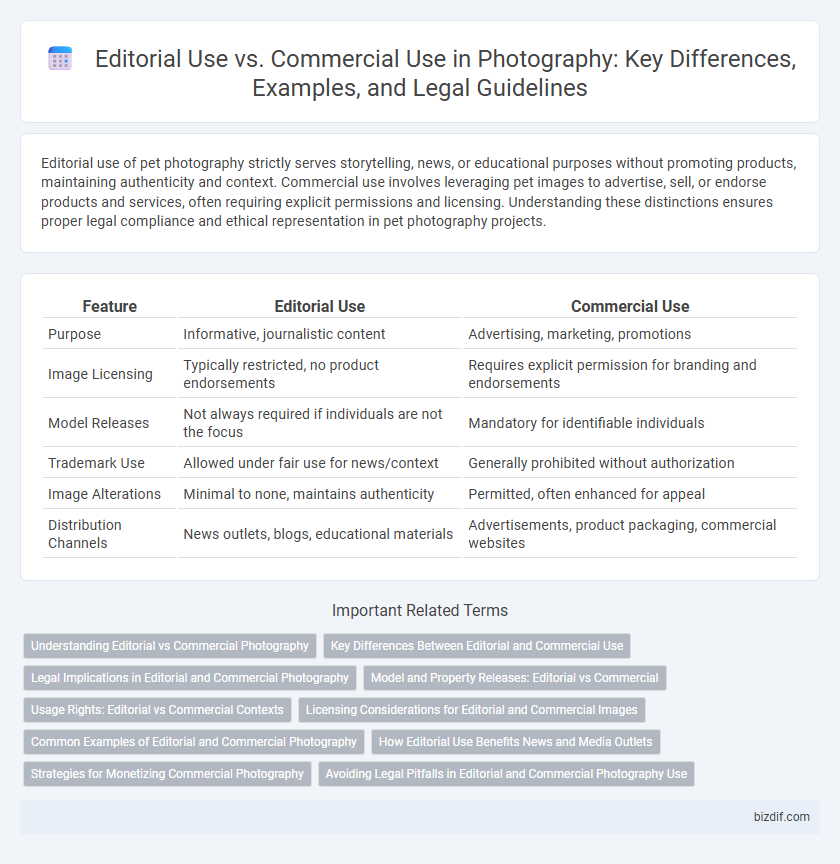Editorial use of pet photography strictly serves storytelling, news, or educational purposes without promoting products, maintaining authenticity and context. Commercial use involves leveraging pet images to advertise, sell, or endorse products and services, often requiring explicit permissions and licensing. Understanding these distinctions ensures proper legal compliance and ethical representation in pet photography projects.
Table of Comparison
| Feature | Editorial Use | Commercial Use |
|---|---|---|
| Purpose | Informative, journalistic content | Advertising, marketing, promotions |
| Image Licensing | Typically restricted, no product endorsements | Requires explicit permission for branding and endorsements |
| Model Releases | Not always required if individuals are not the focus | Mandatory for identifiable individuals |
| Trademark Use | Allowed under fair use for news/context | Generally prohibited without authorization |
| Image Alterations | Minimal to none, maintains authenticity | Permitted, often enhanced for appeal |
| Distribution Channels | News outlets, blogs, educational materials | Advertisements, product packaging, commercial websites |
Understanding Editorial vs Commercial Photography
Editorial photography captures real-life events, news stories, or authentic moments without staging, serving journalistic or storytelling purposes. Commercial photography is created to promote products, services, or brands, involving controlled settings and creative direction to influence consumer behavior. Understanding the distinction affects licensing, usage rights, and legal requirements in photography projects.
Key Differences Between Editorial and Commercial Use
Editorial use in photography refers to images utilized in news articles, blogs, or educational content where the primary goal is to inform or comment on current events without promoting products. Commercial use involves images specifically created or licensed to advertise, endorse, or promote goods, services, or brands, often requiring model and property releases. Key differences include usage intent, licensing requirements, and the necessity for permissions to avoid legal issues in commercial contexts.
Legal Implications in Editorial and Commercial Photography
Editorial use of photographs is restricted to non-commercial contexts such as news reporting, commentary, or educational purposes, often requiring model or property releases only when identifiable subjects are featured. Commercial use involves images for advertising, merchandising, or promotional activities, necessitating comprehensive legal clearances including model releases, property releases, and licensing agreements to avoid infringement issues. Unauthorized commercial exploitation can result in legal actions such as claims for breach of contract, misappropriation, or violation of privacy rights, emphasizing the need for clear legal understanding in photography contracts.
Model and Property Releases: Editorial vs Commercial
Model and property releases are crucial in photography, differentiating editorial use from commercial use. Editorial use allows images to be published in news, magazines, or blogs without releases, as the focus is on informing or educating the public. Commercial use requires signed model and property releases to legally protect the photographer and client when images promote products, services, or brands for profit.
Usage Rights: Editorial vs Commercial Contexts
Editorial use rights allow images to be published in contexts such as news articles, blogs, or educational content where the focus is on information or commentary without promoting a product. Commercial use rights grant permission to utilize images in advertising, marketing, or any for-profit projects aimed at promoting goods or services. Understanding the distinction between editorial and commercial usage rights is essential to comply with copyright laws and avoid legal repercussions in photography.
Licensing Considerations for Editorial and Commercial Images
Editorial use licenses allow images to be used in news, blogs, documentaries, and other non-commercial contexts where the focus is on reporting or commentary without promotion of products or services. Commercial use licenses permit images to be used for advertising, marketing, merchandising, and other profit-driven purposes, typically requiring explicit model and property releases to avoid legal issues. Understanding the distinction in licensing is crucial to ensure compliance, protect intellectual property rights, and prevent potential legal disputes related to unauthorized image use.
Common Examples of Editorial and Commercial Photography
Editorial use in photography typically includes images featured in newspapers, magazines, blogs, and documentaries where the focus is on newsworthy content, events, or storytelling without promoting products. Common examples are photos of celebrities at public events, political rallies, or natural disasters used to illustrate articles. Commercial use involves images created for advertising, marketing campaigns, product packaging, and brand promotion, such as photos showcasing clothing lines, food products, or luxury cars in advertisements and catalogs.
How Editorial Use Benefits News and Media Outlets
Editorial use licenses allow news and media outlets to publish images that depict real events, people, or places without requiring model or property releases, ensuring legal compliance and ethical journalism. This type of usage provides authentic visual content essential for storytelling, reporting, and informing the public, enhancing engagement and credibility. Editorial images support media outlets by delivering timely, relevant visuals that align with newsworthy topics, boosting audience trust and content value.
Strategies for Monetizing Commercial Photography
Monetizing commercial photography requires a clear understanding of licensing agreements that distinguish editorial use from commercial use, with the latter involving promotional, advertising, and product-driven applications. Photographers can maximize revenue by pricing usage rights based on market reach, duration, and exclusivity, often incorporating tiered licensing models that accommodate different client needs. Strategic partnerships with brands and agencies, combined with proactive rights management and digital asset tracking, enhance income potential while protecting intellectual property.
Avoiding Legal Pitfalls in Editorial and Commercial Photography Use
Editorial photography usage is primarily intended for newsworthy or educational content, which requires proper attribution and adherence to fair use guidelines to avoid copyright infringement. Commercial photography use involves promoting products or services, demanding explicit model and property releases to prevent legal disputes over image rights. Understanding these distinctions helps photographers and clients navigate copyright law and avoid costly legal pitfalls in both editorial and commercial projects.
Editorial Use vs Commercial Use Infographic

 bizdif.com
bizdif.com